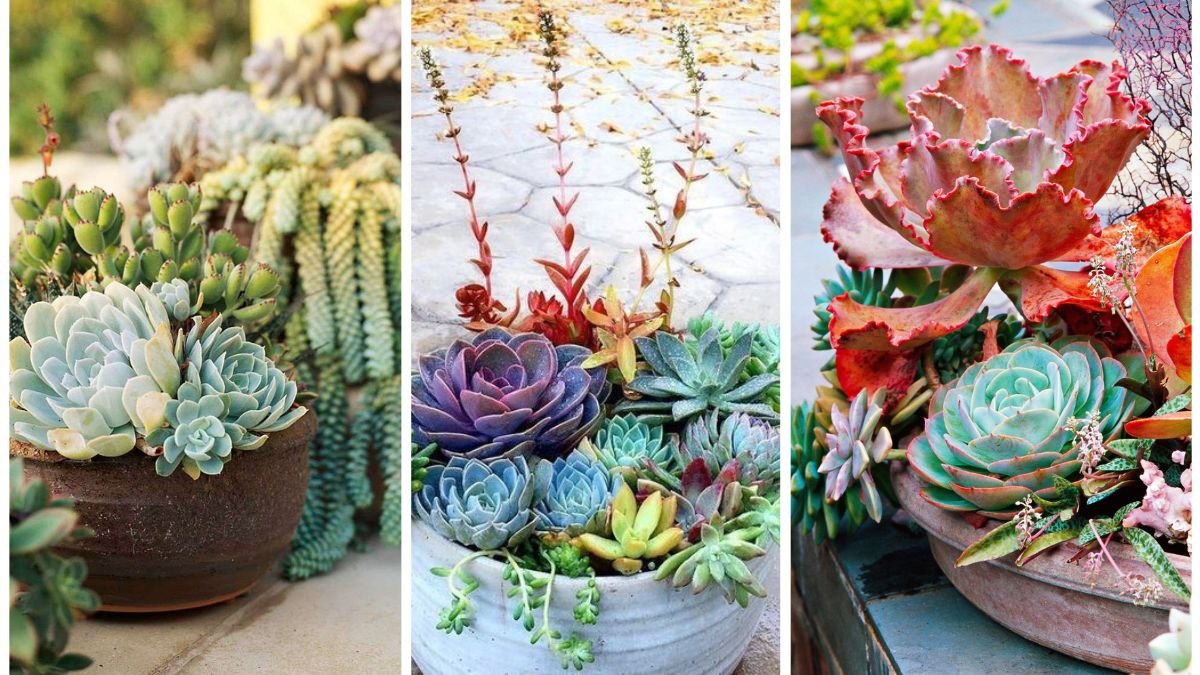Succulents have taken the gardening world by storm—and for good reason. These hardy, low-maintenance plants come in endless shapes, colors, and textures that can transform even the smallest space into a captivating green display. From their ability to thrive in minimal water to their sculptural appeal, succulents are perfect for modern container gardens.
Creating a stunning succulent container garden isn’t just about throwing a few plants in a pot. It’s about combining the right container, soil, and plant varieties in a way that highlights their beauty while ensuring long-term health. Whether you’re a beginner or an experienced gardener, this guide will walk you through everything you need to know to design a succulent garden that’s both eye-catching and easy to care for.
Why Choose Succulents for Container Gardens?
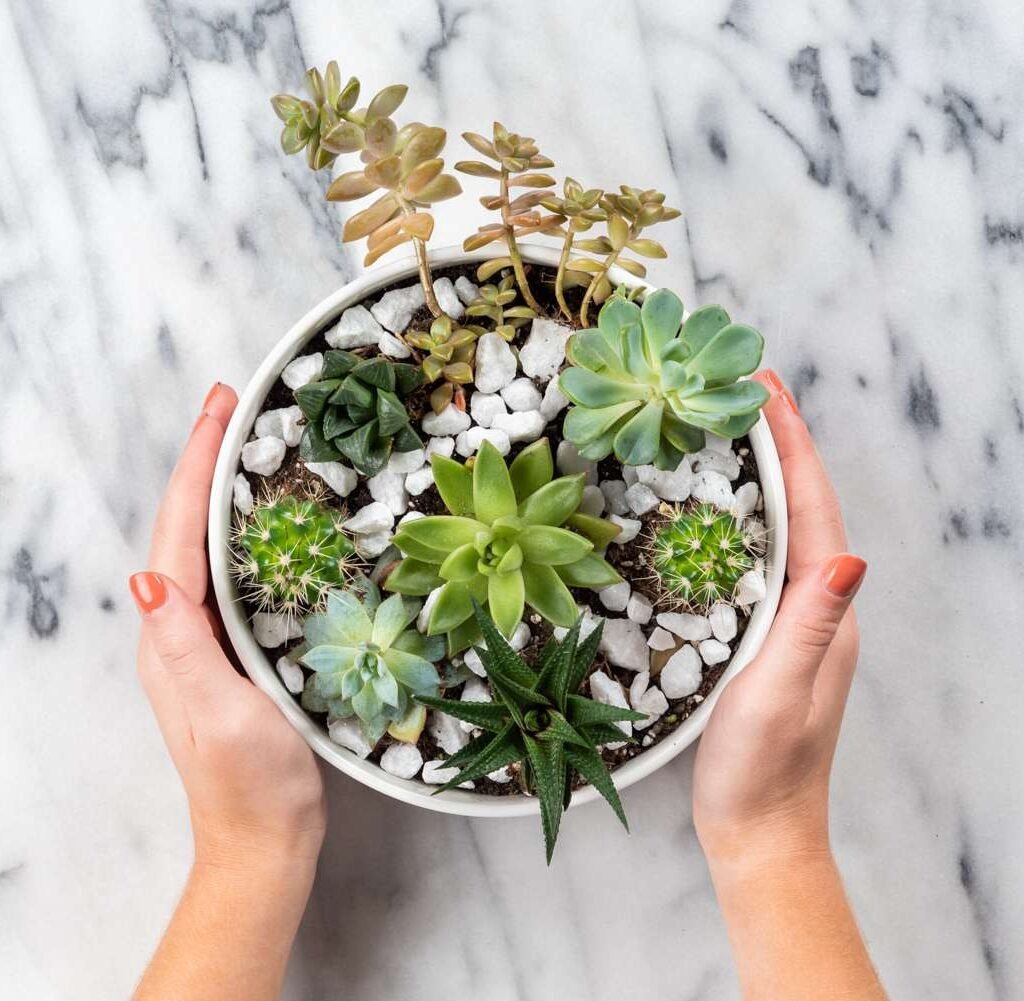
Before diving into the “how,” let’s understand why succulents make such excellent candidates for container gardening.
- Low Maintenance: Succulents require minimal watering and thrive with little intervention.
- Versatile Designs: Their variety in size, form, and color makes them excellent for creative arrangements.
- Space-Saving: Perfect for apartments, balconies, patios, or desks.
- Durable: Succulents withstand heat, drought, and neglect better than many other plants.
- Year-Round Appeal: Many varieties keep their structure and color even in cooler seasons.
With these advantages, it’s no wonder succulents have become a favorite for both novice and expert gardeners.
Step 1: Choosing the Right Container
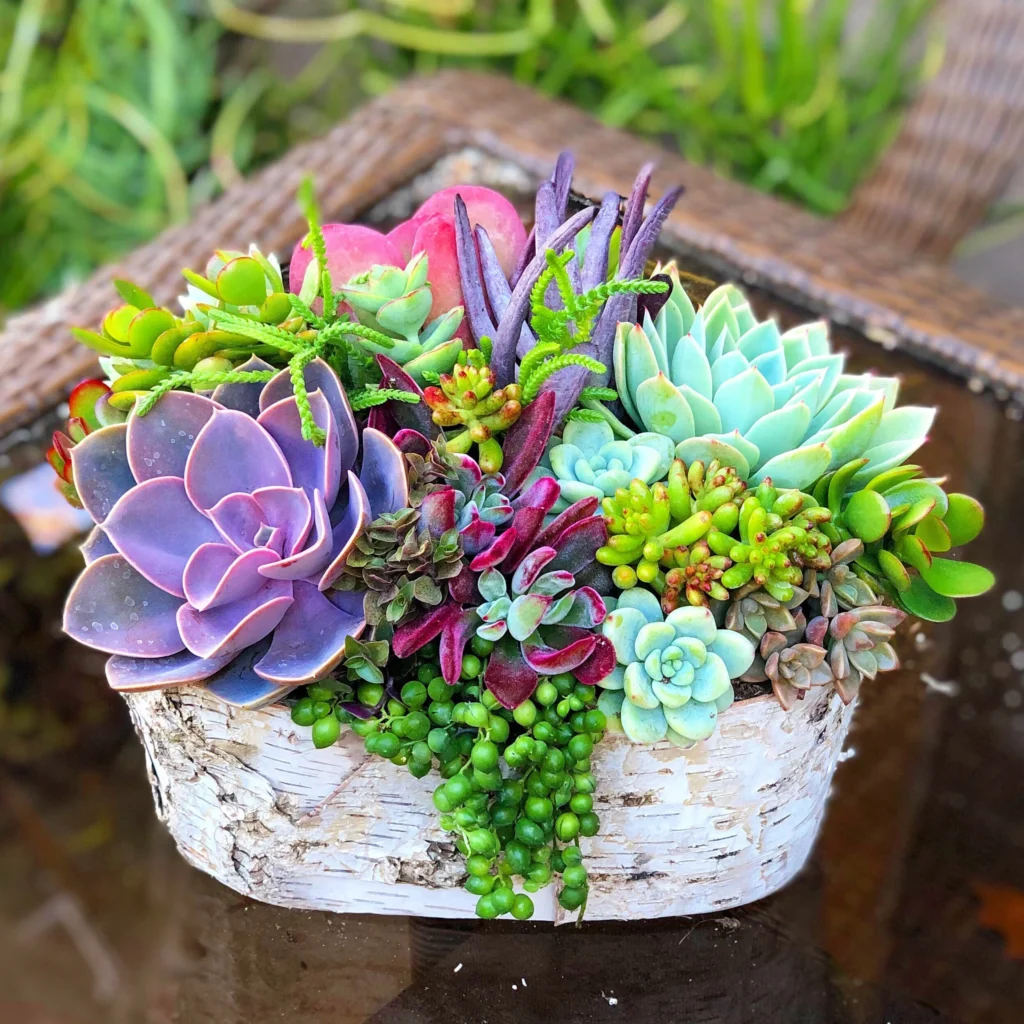
The container sets the stage for your succulent garden. A beautiful container can elevate the entire display, while the wrong one can cause drainage problems or overwhelm the plants.
Factors to Consider:
- Drainage:
Succulents hate soggy soil. Always select containers with drainage holes at the bottom to prevent root rot. - Material:
- Terracotta or clay pots: Porous and breathable, helping soil dry quickly.
- Ceramic pots: Stylish but may retain more moisture; ensure proper drainage.
- Metal or glass containers: Modern-looking but prone to heating up or poor drainage; use with caution.
- Wooden planters: Rustic charm but may deteriorate over time if not sealed.
- Size and Depth:
Succulent roots are shallow, so wide, shallow containers usually work best. This also allows for artistic arrangements. - Style:
Match your container to your desired look—minimalist, rustic, or colorful. A container can be a focal point as much as the plants themselves.
Step 2: Preparing the Perfect Soil Mix
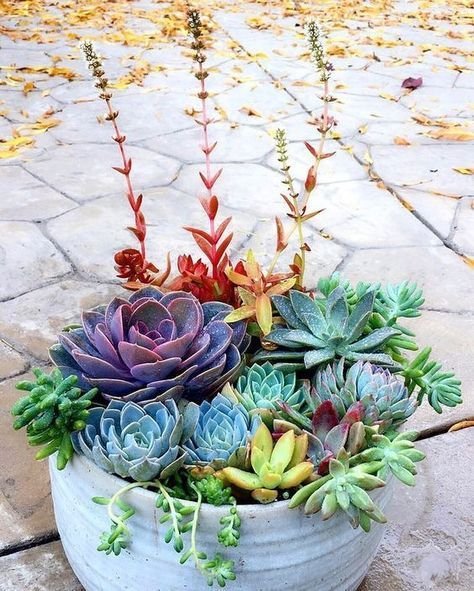
Succulents need well-draining soil to thrive. Standard garden soil is too dense and retains too much water.
Best Soil Options:
- Commercial succulent or cactus mix: Readily available and designed for drainage.
- DIY mix: Combine 2 parts potting soil, 1 part coarse sand, and 1 part perlite or pumice.
Extra Tips:
- Place a layer of small gravel or mesh at the bottom of the container to keep soil from clogging drainage holes.
- Avoid moisture-retentive soils with high peat content—they suffocate roots.
Step 3: Selecting the Right Succulents
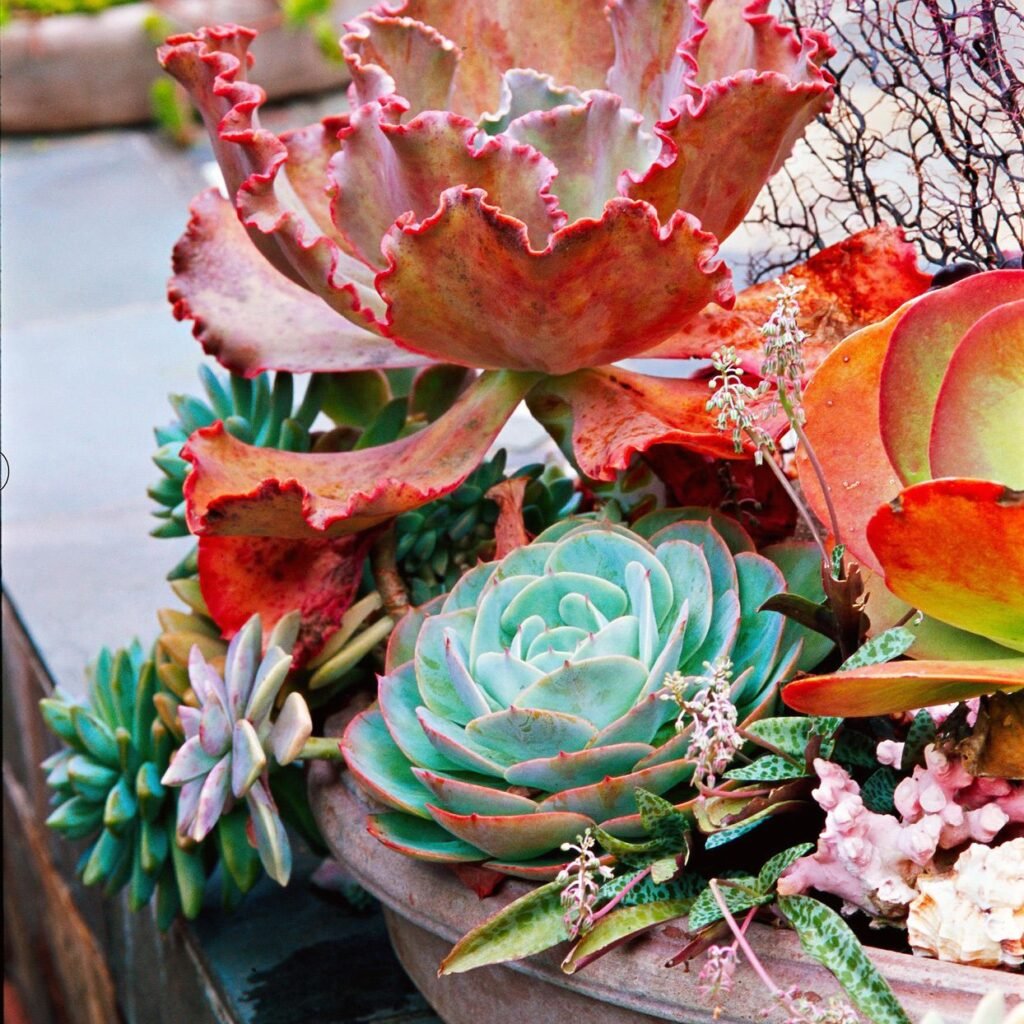
Here’s where the fun begins. Succulents come in endless varieties, so mix and match shapes, colors, and textures for a visually striking garden.
Popular Choices for Containers:
- Rosette-form succulents: Echeveria, Sempervivum (Hens-and-Chicks) – perfect centerpieces.
- Trailing varieties: String of Pearls, Burro’s Tail, String of Bananas – cascade beautifully over container edges.
- Architectural types: Aloe, Haworthia, Agave – provide structure and height.
- Colorful succulents: Kalanchoe, Sedum rubrotinctum – add red, pink, or yellow accents.
Planting Tip:
Select 3–5 varieties with contrasting shapes (spiky, round, trailing) and colors for balance and interest.
Step 4: Designing Your Arrangement

Arranging succulents is an art form. Think of it like designing a miniature landscape.
Basic Design Principles:
- Thriller, Filler, Spiller Rule:
- Thriller: A tall or striking succulent (like Aloe or Agave) as the centerpiece.
- Filler: Medium plants (Echeveria, Haworthia) that surround the centerpiece.
- Spiller: Trailing succulents (String of Pearls, Sedum) cascading over edges.
- Balance and Symmetry:
Avoid overcrowding. Leave space for growth and maintain balance. - Color Coordination:
Pair greens with purples, blues, or reds for contrast. Use neutral containers to let the plants shine. - Texture Variety:
Mix smooth-leaved succulents with spiky or fuzzy ones for added depth.
Step 5: Planting Your Succulent Garden
Here’s a step-by-step process:
- Fill the container with succulent soil, leaving about an inch of space at the top.
- Start with your centerpiece succulent in the middle or back (depending on viewing angle).
- Add surrounding plants (fillers), arranging by size and color.
- Place trailing succulents near the edges.
- Gently pack soil around roots, leaving crowns above soil level to prevent rot.
- Add decorative top dressing like pebbles or gravel for a polished finish.
Step 6: Caring for Your Succulent Garden
Once planted, succulents are easy to care for, but they do have specific needs.
Watering:
- Water deeply but infrequently. Let soil dry completely between waterings.
- Avoid overhead watering—wet leaves can rot. Instead, water at soil level.
Light:
- Place in bright, indirect sunlight or near a south-facing window.
- Outdoors, succulents thrive in 4–6 hours of sunlight daily.
Temperature:
- Succulents prefer warm climates but can tolerate cooler nights.
- Protect from frost; bring containers indoors during winter if necessary.
Fertilizing:
- Feed lightly during the growing season (spring/summer) with diluted cactus fertilizer.
- Avoid fertilizing in winter when growth slows.
Step 7: Creative Styling Ideas
A succulent container garden is not just about plants—it’s a statement piece. Here are some creative twists:
- Mini Fairy Gardens: Add tiny figurines, houses, or pathways for whimsical charm.
- Themed Containers: Use teacups, vintage tins, or wooden crates for a unique style.
- Color Palettes: Create monochrome gardens (all green or all purple) or mix complementary hues.
- Indoor Table Centerpiece: Arrange succulents in a long, shallow tray for dining or coffee tables.
- Outdoor Sculptures: Plant succulents in wall frames or wreaths for vertical displays.
Common Mistakes to Avoid
- Overwatering: The number one cause of succulent death.
- Using Wrong Soil: Heavy, moisture-retentive soil will suffocate roots.
- Poor Light Placement: Succulents will stretch and lose color in low light.
- Crowding Plants: Succulents need airflow to prevent fungal diseases.
- Neglecting Drainage: Containers without holes are risky unless used with inner liners.
Conclusion
Succulent container gardens combine practicality with beauty, offering a low-maintenance, high-impact way to bring greenery into any space. By carefully selecting the right container, soil, plant varieties, and arrangement, you can design a miniature masterpiece that thrives with minimal care.
Whether you’re decorating a sunny balcony, brightening up your living room, or creating a striking patio display, succulents are versatile companions that reward creativity. With just a little planning and a few thoughtful touches, your succulent garden will become a stunning focal point that lasts for years.
